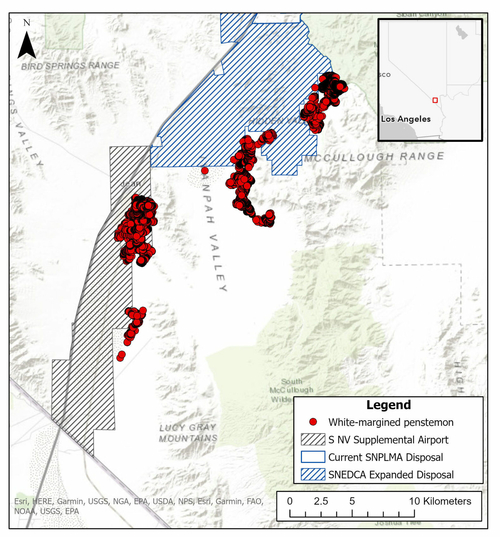‘A very political little wildflower’ in danger of extinction in Southern Nevada

Like many deserts, lack of rainfall in the Mojave has pushed life to the furthest limits of adaptation, saturating the region with rare and unique species found nowhere else in the world.
In fact, one-fourth of plant species growing in the Mojave Desert—the smallest of four major deserts in North America—are one of a kind.
One of those plants is the white-margined penstemon, a small pink bell-shaped flower fixed on long hardy stems with waved oblong leaves. The highly adapted flower has carved a niche in the Mojave by occupying sandy desert washes, valley floors, and mountain foot-slopes where little else grows.

The rare wildflower only grows in four counties across the Mojave Desert: Clark County, Nye County, San Bernardino County in California, and Mohave County in Arizona.
But the imperiled wildflower faces a number of threats to its survival, including urban sprawl, climate change, energy development, off-road recreation, and invasive grasses.
Development in Clark County is growing fast due to out of state migration in recent decades and land-intensive industrial developments, the latter marked most notably by a sprawling warehouse economy.
Lawmakers have sought to expand city boundaries for development recently, one major bid being the Clark County Lands Bill proposed by Nevada Democratic U.S. Sen. Catherine Cortez Masto and supported by the rest of the congressional delegation as well as the Clark County Commission.
The lands bill would designate millions of acres for conservation, but also massively expand urban sprawl and development, endangering the rare wildflower.
Large developments have already been planned on one of the sole known populations of the rare wildflower. The proposed Ivanpah Airport, or the Southern Nevada Supplemental Airport, has been stalled since 2010, but if constructed, could wipe out much of the flower’s Clark County population.
Another potential threat to the white-margined penstemon’s population is NV Energy’s proposed Greenlink West transmission line and associated solar development in Nye County. The transmission line would cut through Nye County, where the flower has a poorly documented but significant population.
In 2020, NV Energy proposed the 600 mile Greenlink project – a western transmission line from Las Vegas to Yerington, and a northern line from Yerington to Ely. The PUC allowed NV Energy to proceed on the western line but only allowed permitting and land acquisition, not construction, of the northern line.
State lawmakers stepped in and approved the entire plan in 2021.
Still, state utility regulators partially denied the development because of the potential cost to ratepayers. Last year NV Energy asked federal regulators to grant permission for the utility to come back and request that ratepayers offset the costs of the project’s construction and pay for its troubles should Greenlink be canceled.
NV Energy is owned by Berkshire Hathaway Energy, an arm of the Berkshire Hathaway, Inc. multinational conglomerate chaired by Warren Buffett that posted a record $30.8 billion in operating income last year.
“Given the significant implications on the Clark County Lands bill and the Greenlink West transmission line, this is a very political little wildflower,” said Patrick Donnelly, the Great Basin director for the Center for Biological Diversity.
On Thursday, the Center for Biological Diversity petitioned the U.S. Fish and Wildlife Service to list the white-margined penstemon as threatened or endangered under the Endangered Species Act.
“Habitat loss and catastrophic drought have pushed these delicate wildflowers to the brink, and only the Endangered Species Act can save them now,” said Donnelly.
Even without large-scale development in the flower’s habitat, a 2021 study commissioned by the U.S. Fish and Wildlife Service found a 50% chance of extinction for the wildflower in the next 50 years due to climate change and habitat destruction. While the global population of the white-margined penstemon has fluctuated over time, recent surveys indicate that all four population centers are in decline.
Federal wildlife managers said 2021 was among the driest and warmest years on record for the Mojave Desert. Increasing aridification caused by prolonged drought and climate change is likely to limit population growth, and recovery, effectively bringing the rare wildflower to the brink of extinction, according to researchers.
The most recent estimate for the flower’s Clark County and Nye County population centers is around 34,000 for both, considerably lower than previous years, according to researchers.
Federal and state agencies have had the wildflower on their radar for years. The Bureau of Land Management lists the white-margined penstemon as a sensitive species in Arizona, California, and Nevada. The Nevada Department of Natural Heritage considers the wildflower “at-risk,” and it’s listed as a covered species under Clark County Department of Comprehensive Planning. However, those designations do not provide the binding protection or enforcement needed to prevent the wildflower’s extinction.
“Las Vegas sprawl has already consumed a quarter-million acres of prime Mojave Desert habitat, and now greedy developers are eyeing one of the last strongholds of the white-margined penstemon,” said Donnelly. “This rare wildflower needs the Endangered Species Act so it doesn’t end up under the blade of a bulldozer authorized by Sen. Cortez Masto’s sprawl bill.”


